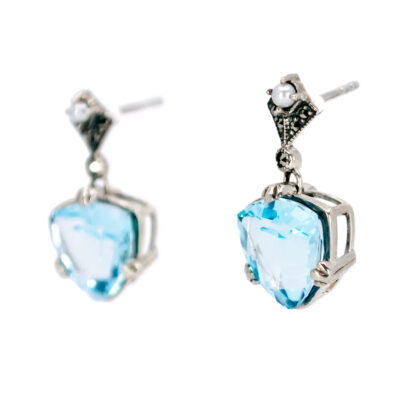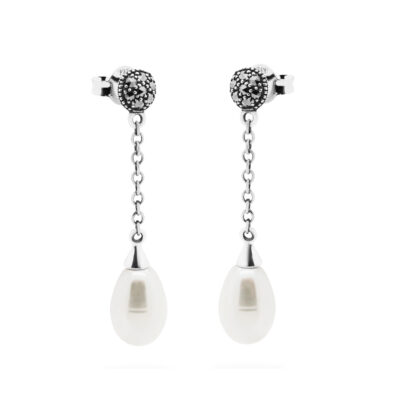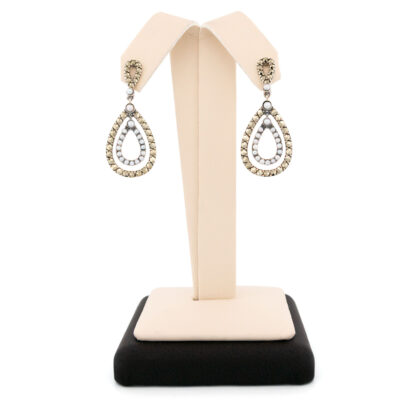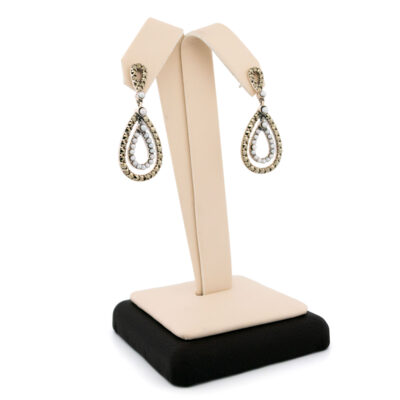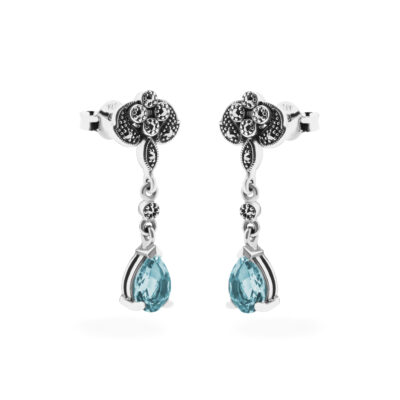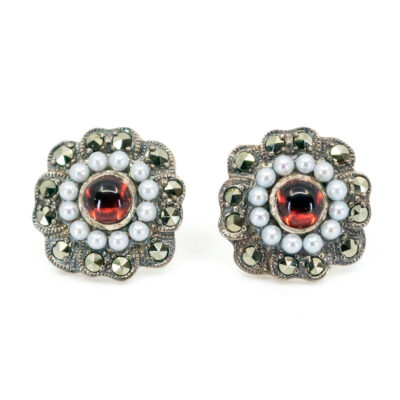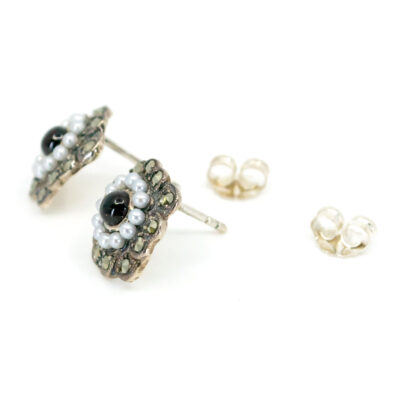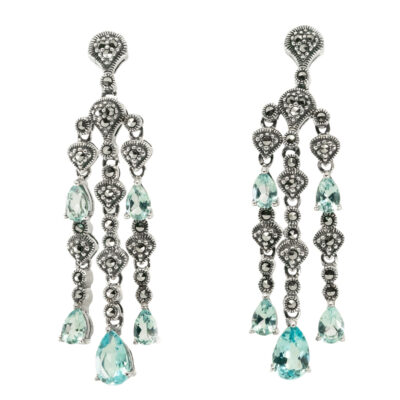These mesmerizing Victorian-design pendant earrings features pear-shaped approx. 20.00ct topaz as the centerpiece accented with pearls, beautifully crafted in Silver.
Videos
Details: ±20.00ct Topaz, Pearls, Silver Earrings.
Design Era: New Victorian.
Weight in grams: 8.8.
Condition: New.
Shipping and Pickup: This mesmerizing piece ships from our store located in the center of Amsterdam, The Netherlands. We offer both registered shipping and local pickup at our store. In the case of local pickup, any applicable shipping costs will be refunded.
About Us: Add some sparkle to your style with Binenbaum.com. We offer a stunning selection of antique and vintage jewelry that you won’t find anywhere else. From timeless rings and dazzling necklaces to unique brooches, we have something for every taste and occasion. Visit our website today and treat yourself to a piece of history.
| Design Era | |
|---|---|
| Design & Historical Context | The Victorian Era spanned Queen Victoria's rule of England from 1837 until 1901. During this time, a middle class began to emerge, sparking a demand for jewelry in the mass market, jewelry trends often reflected the tone of current events. The era is usually divided into several subsections: the Romantic Period from 1837 to 1861, the Grand Period from 1861 to 1880, and the Aesthetic Period from 1880 to 1901. During the Romantic Period jewelry also featured nature-inspired designs, similar to jewelry of the Georgian era. Frequently, these designs were delicately and intricately etched into gold. Lockets and brooches were popular in daytime jewelry during the early Victorian era, whereas colored gemstones and diamonds were worn during the evening. During the Grand Period jewelry , because the Grand or Mid-Victorian era corresponded with the death of Queen Victoria's husband, many jewelry pieces have solemn, somber designs. Known as mourning jewelry, the pieces feature heavy, dark stones. Jet, onyx, amethyst, and garnet are frequently found in jewelry from this period. Compared to previous periods, Mid-Victorian-era jewelry features highly creative, colorful designs using shells, mosaics and gemstones. During the Aesthetic period, jewelers used diamonds and feminine, bright gemstones such as sapphire, peridot, and spinel. Star and crescent designs as well as elaborate hat pins were also popular. Some scholars believe the aesthetic era began sooner, in 1875, and ended as early as 1890. |
| Key Materials | |
| Materials & Craftsmanship | Topaz: The Gem of Clarity and Strength Topaz, known for its brilliant clarity and wide range of colors, is a gemstone that symbolizes strength, healing, and abundance. While naturally colorless, topaz can be found in a variety of hues including golden yellow, blue, pink, and even rare red, with some colors resulting from natural processes and others enhanced by treatments. Historically, topaz has been associated with powerful metaphysical properties. In ancient Egypt, it was believed to be a gift from the sun god Ra, offering protection and healing. The name topaz is thought to derive from the Sanskrit word tapas, meaning fire, or from the ancient Greek island of Topazios, where the stone was first mined. In modern jewelry, topaz is valued for its brilliance and versatility. With a Mohs hardness of 8, topaz is durable enough for everyday wear, making it a popular choice for rings, pendants, earrings, and bracelets. Blue topaz, in particular, has become a favorite for its cool, calming color, often set in silver or white gold to enhance its sparkling clarity. Topaz is more than just a gemstone; it is a symbol of clarity, resilience, and positive energy. Whether chosen for its vibrant color or its deep symbolic meanings, topaz makes an elegant and meaningful choice for jewelry that is both beautiful and enduring. Pearl: The Gem of Elegance and Purity Pearls, with their natural luster and timeless beauty, are one of the most revered gemstones in the world. Unlike other gems, pearls are organic, formed within the soft tissue of mollusks like oysters and mussels. Their formation process results in a smooth, round gem with a soft, iridescent glow, often referred to as the pearl essence. Historically, pearls have been a symbol of purity, wisdom, and wealth. In ancient Rome, they were considered the ultimate status symbol, while in ancient China, pearls were believed to protect against fire and dragons. During the Renaissance, pearls were so highly valued that they were reserved for royalty and nobility, symbolizing perfection and integrity. In modern jewelry, pearls are cherished for their classic elegance and versatility. They are commonly found in a range of colors, from the traditional white and cream to rare black, pink, and golden hues. Pearls are often strung into necklaces, set into earrings, or used as delicate accents in rings and bracelets. Their softness, with a Mohs hardness of 2.5 to 4.5, requires gentle care, but their beauty and sophistication are unmatched. Pearls are more than just a gem; they are a symbol of grace, purity, and timeless style. Their natural origins and understated elegance make them a beloved choice for jewelry that exudes refinement and sophistication. Silver: The Metal of Elegance and Versatility Silver, known for its bright, reflective luster, is one of the most beloved and widely used precious metals in the world. This versatile metal has been cherished for thousands of years, not only for its beauty but also for its malleability, making it ideal for crafting intricate and delicate jewelry designs. Historically, silver has been associated with the moon and considered a symbol of purity, clarity, and protection. Ancient civilizations, from the Egyptians to the Greeks and Romans, valued silver for its beauty and used it to create coins, jewelry, and religious artifacts. In many cultures, silver is also believed to have healing properties, often used in amulets and talismans to ward off negative energy. In modern jewelry, silver is prized for its affordability, versatility, and timeless appeal. Sterling silver, an alloy of 92.5% pure silver and 7.5% other metals (usually copper), is the standard used in high-quality jewelry. Its durability and bright, reflective surface make it an excellent choice for a wide range of designs, from minimalist pieces to ornate creations. Silver can be polished to a high shine or given a matte, oxidized, or antiqued finish to suit various styles. Silver is more than just a metal; it is a symbol of elegance, flexibility, and understated luxury. Its enduring popularity and wide-ranging applications make it a staple in jewelry that can complement any look, from casual to formal, with timeless grace. |
| Gender | |
| Weight (in grams) | 8.8 |
| Condition |
By following these tips, you can enjoy your precious jewelry for many years to come.
Related Products
-
Topaz Pearl Marcasite (Pyrite) Silver Pendant Earrings 14658-1742
€ 265,00 VAT incl. (where applicable) -
Marcasite (Pyrite) Pearl Silver Drop Earrings 14857-1932
€ 165,00 VAT incl. (where applicable) -
Marcasite (Pyrite) Pearl Silver Drop Earrings 14157-1492
€ 265,00 VAT incl. (where applicable) -
Marcasite (Pyrite) Topaz Silver Drop Earrings 13668-1369
€ 135,00 VAT incl. (where applicable) -
Garnet Marcasite (Pyrite) Pearl Silver Floral Cluster Stud Earrings 16833-2732
€ 175,00 VAT incl. (where applicable) -
Topaz Marcasite (Pyrite) Silver Girandole Earrings 12005-7290
€ 335,00 VAT incl. (where applicable) -
Marcasite (Pyrite) Pearl Silver Earrings 15320-2073
€ 75,00 VAT incl. (where applicable) -
Marcasite (Pyrite) Topaz Silver Pendant Earrings 16443-2591
€ 120,00 VAT incl. (where applicable)
- Home
- Collection
- Fine Jewelry
- Silver Jewelry
- Silverware
- Boxes
- Candlesticks
- Salt and pepper shakers
- Miniatures
- Salt cellars
- Spoon Set
- Condiments
- Frames
- Napkin Ring
- Spoon
- Oddities
- Cups
- Vases
- Cutlery
- Serving Spoon And Cake Server
- Candlesticks
- Baskets
- Hanukkiah
- Spice Tower
- Yad
- Tea Set
- Sugar Castor
- Napkin Rings
- Wine Bottle Coaster
- Wine Stopper
- Tea Pot
- Jugs
- Rattles
- Hip Flask
- Miscellaneous
- Rings 💍
- About
- Contact



